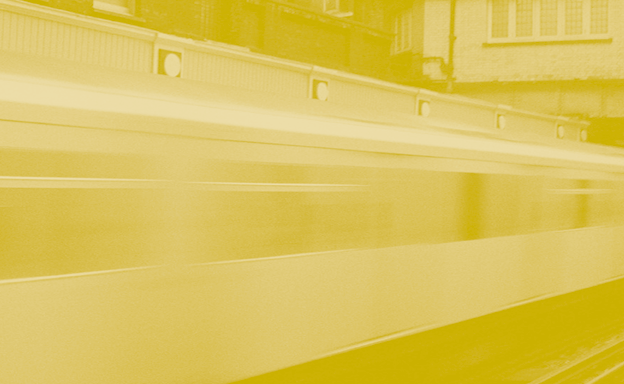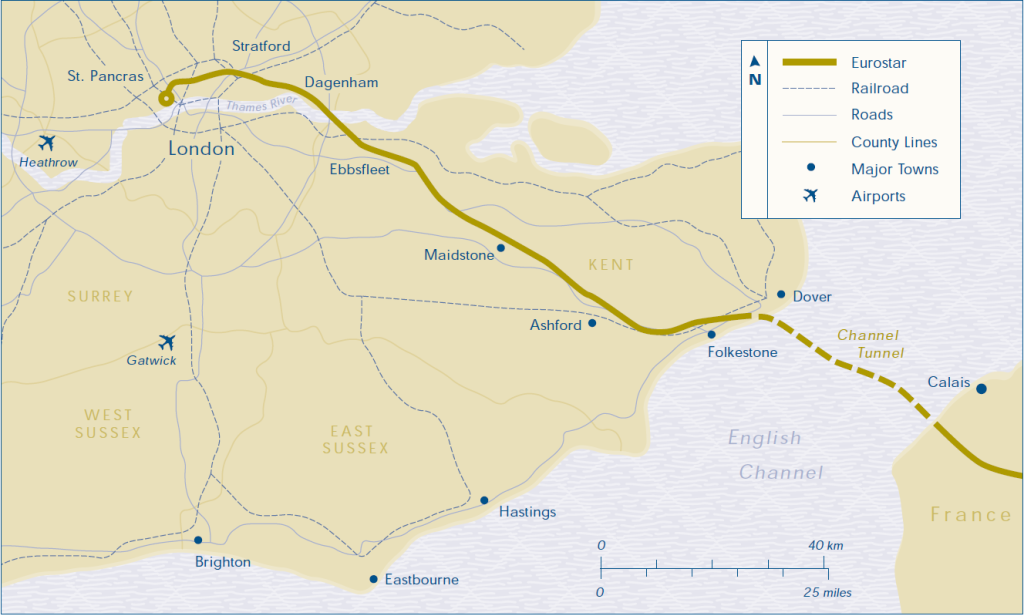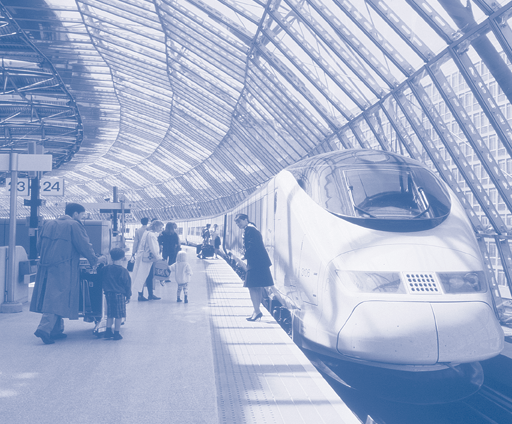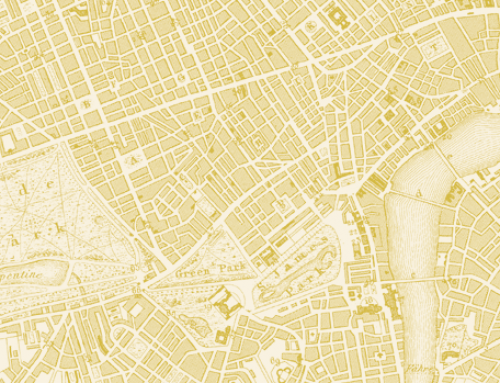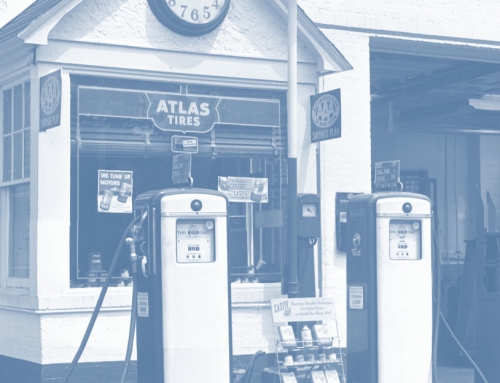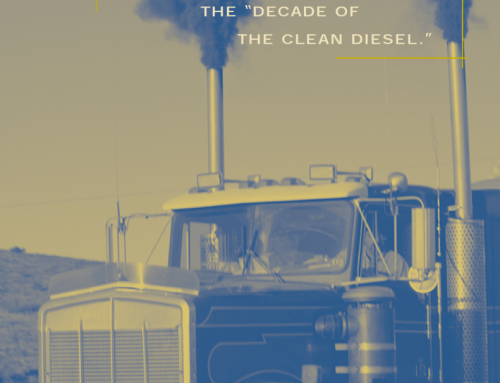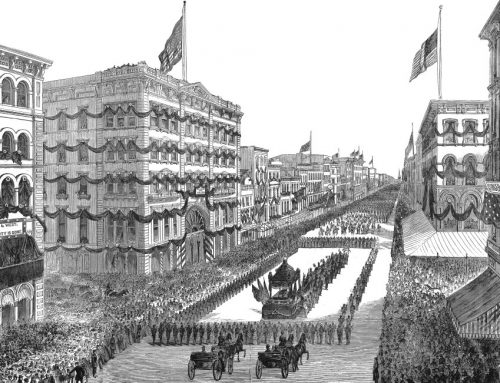 Right now, monster traffic jams surround London’s St. Pancras station as they dig up the space in front of the great neo-Gothic Victorian pile to build an extension to the Underground station. As drivers sit motionless, they see mysterious red signs directing traffic to mysterious destinations: “CTRL WORKS TRAFFIC 1J,” “CTRL WORKS TRAFFIC 2J-4J.” The explanation can be found not far away, at the back of the station: behind security fences, Victorian coal gas tanks are being demolished or (because some are landmark structures) moved, while giant tunnel-boring machines are eating into the London clay. All this frenetic activity has one purpose: construction of the Channel Tunnel Rail Link, Stage Two—the UK’s new link to the continent of Europe, and one of the largest civil engineering projects since Victorian times—at last happening.
Right now, monster traffic jams surround London’s St. Pancras station as they dig up the space in front of the great neo-Gothic Victorian pile to build an extension to the Underground station. As drivers sit motionless, they see mysterious red signs directing traffic to mysterious destinations: “CTRL WORKS TRAFFIC 1J,” “CTRL WORKS TRAFFIC 2J-4J.” The explanation can be found not far away, at the back of the station: behind security fences, Victorian coal gas tanks are being demolished or (because some are landmark structures) moved, while giant tunnel-boring machines are eating into the London clay. All this frenetic activity has one purpose: construction of the Channel Tunnel Rail Link, Stage Two—the UK’s new link to the continent of Europe, and one of the largest civil engineering projects since Victorian times—at last happening.
It’s the cumulation of a long-drawn-out story that has had many false starts and some premature near-endings. Some of us, who’ve been associated with it over the years, had almost given up all hope that we’d live to see this day. We see it as some kind of miracle. A ta time when California and the United States are in the throes of a debate about high-speed rail transportation, spurred by the huge disruption to the airlines following the September 11 disaster, it’s a tale worth recounting.
It began long ago: in 1986, UK Prime Minister Margaret Thatcher and France’s President François Mitterrand signed the Treaty of Canterbury, the legal instrument that allowed the two countries to cooperate in building the Channel Tunnel. The tunnel itself started construction the 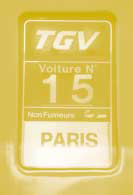 following year and opened to traffic in 1994: a rail-only tunnel, carrying a mixture of freight trains, flat bed wagons that carry roll-on roll-off cars and trucks in a constant shuttle, and high-speed Eurostar trains connecting London with Paris and Brussels. At the French end, the Eurostars continue onto a brand-new high-speed railway completed just before the tunnel opened, carrying TGVs ( Trains à Grande Vitesse, High-Speed Trains) at 186 mph all the way to the outskirts of Paris, and now extended from Lille through Belgium to Brussels. But on the UK side, the twenty-car Eurostars trundle at a slower pace—maximum 90 mph—mixed in with London com- muter trains. As Mitterrand jested when the tunnel opened, it gives plenty of time to enjoy the beauties of the English countryside.
following year and opened to traffic in 1994: a rail-only tunnel, carrying a mixture of freight trains, flat bed wagons that carry roll-on roll-off cars and trucks in a constant shuttle, and high-speed Eurostar trains connecting London with Paris and Brussels. At the French end, the Eurostars continue onto a brand-new high-speed railway completed just before the tunnel opened, carrying TGVs ( Trains à Grande Vitesse, High-Speed Trains) at 186 mph all the way to the outskirts of Paris, and now extended from Lille through Belgium to Brussels. But on the UK side, the twenty-car Eurostars trundle at a slower pace—maximum 90 mph—mixed in with London com- muter trains. As Mitterrand jested when the tunnel opened, it gives plenty of time to enjoy the beauties of the English countryside.
The reason was that the treaty contained a clause saying that no state money could be used to build the tunnel or any associated works. The French, in their inimitable way, got around that by saying that their TGV Nord was built to carry domestic traffic. No such hope with the parsimonious UK Treasury in charge. They insisted that a high-speed link from the Chunnel to London, like the tunnel itself, had to be a strictly private job in which investors carried the entire risk. Since the Chunnel had been a commercial disaster, with cost overruns that bankrupted the investors—mainly French, as it turned out— that didn’t seem particularly good news.
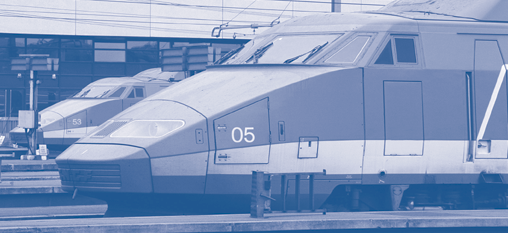
Nonetheless, British Railways—then still a nationalized undertaking—pressed on with a project for a high-speed line. By 1990, it had defined a seventy-mile route running through the county of Kent and the south-east London suburbs to a vast new underground station built between the two major central London termini of King’s Cross and St. Pancras, from where trains could continue to the north of England. But then the whole project became entangled with an emerging great debate about urban regeneration and city planning.
Three years earlier, a planner then with the Kent County Council, Martin Simmons, had published an article in a professional planners’ magazine. In it, he argued that London’s Heathrow airport, built west of the capital for military reasons in 1943, had played an important role in the subsequent growth of the so-called western sector, the UK’s main high-tech cluster. Thus, it had helped reinforce the traditional imbalance in London between a prosperous west and an impoverished east. With a new rail link from the Chunnel, Simmons argued, there was an opportunity to reverse this historic imbalance.
His argument was widely noticed and widely discussed. Butthenthere was a further twist. A major civil engineering and planning consultancy, Ove Arup, decided to take a chance. Led by an economist, Mark Bostock, they began at their own expense to prepare an alternative route for the new line. Instead of entering London through the solidly middle-class southeastern suburbs, their line would tunnel under the Thames to go north of the river, past the giant Ford works at Dagenham and through undeveloped marshland. It could have a station at Stratford in east London, one of the capital’s most deprived areas. Thus it could serve the deprived and underdeveloped eastern side of London, and stations along it could play the same role in the following half-century that Heathrow had played since 1945. Some of us began to argue strongly for the alternative route for precisely that reason.
Thus began a huge national debate. In 1990 Michael Heseltine, a brilliant politician who led the regeneration of the London Docklands and then resigned from Margaret Thatcher’s cabinet on a point of principle, campaigned to become party leader—and thus Prime Minister—in her place. He lost to John Major, who gave him back his old job at the Department of the Environment. In March 1991 he summoned the media for a startling press conference: the Docklands project, then grinding its way to completion, was to be followed by a much larger one: the East Thames Corridor. Running thirty miles downstream through East London and Kent, it was to consist of a whole series of regeneration schemes and new developments—and they could all be strung along the line of the new railway.
 Now the debate intensified. The British Railways line, the Arup line, and yet another private alternative were closely evaluated. The Arup line could cost more money, but it was less disruptive to existing communities and it would bring big regeneration benefits—how big was hard to say, and the experts disagreed. Finally, after a summer of frantic activity, the government announced in October 1991 that the Arup line would be adopted.
Now the debate intensified. The British Railways line, the Arup line, and yet another private alternative were closely evaluated. The Arup line could cost more money, but it was less disruptive to existing communities and it would bring big regeneration benefits—how big was hard to say, and the experts disagreed. Finally, after a summer of frantic activity, the government announced in October 1991 that the Arup line would be adopted.
It took two more years to fix the line in detail. One key decision placed intermediate stations at Stratford in east London, six miles from the St. Pancras terminus, and at Ebbsfleet just over the Kent boundary. Meanwhile the government had decided it should be built and operated by a private consortium. It was busy preparing for the privatization of British Railways, so this was logical. On the rest of the network, impelled in part by a recommendation from the European Commission in Brussels, it split the tracks from the trains: the tracks would be maintained by a monopoly company, Railtrack, while operations would be franchised out to a score of regional and local companies. But, oddly, for the new link the government departed from its own logic. On the high-speed line it decided to maintain integration. There would be a competition to build and operate the new line. The new Eurostar trains, just starting to operate over the 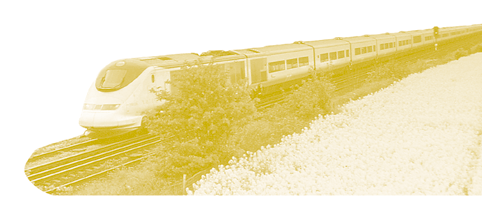 old tracks, would be passed to the winning consortium. And on top, the consortium would get some potentially valuable development land around the new stations.
old tracks, would be passed to the winning consortium. And on top, the consortium would get some potentially valuable development land around the new stations.
The winner of the competition, announced late in 1995, was London & Continental Railways. L&C was a consortium that included Arup, Bechtel, a division of the French National Railways (SNCF), and Virgin, Richard Branson’s legendary company that had started selling music records and now sold almost everything; it was just completing a successful bid to operate one of the main rail lines in Britain, from London to Birmingham, Manchester, Liverpool, and Glasgow. A key element in the L&C bid, reached only after intense internal debate, was to build a direct link outside St. Pancras so that trains from the Virgin line could run directly on to the new link without entering and reversing in the station. This neatly provided for direct services from British provincial cities to the European mainland, and also ensured that their London stop would be at Stratford. It may have proved the clinching element. But in any event it was of great strategic importance, because these two elements—connection to other British cities and stop in eastern London—were being called for by the European Commission to complete the Trans European Network (TEN) of highways and high-speed railways that would connect the major cities of Europe.
But, three years after winning the competition and on the eve of the start of construction, L&C made a momentous announcement: it could not afford to go ahead. The reason was that traffic growth on the existing Eurostar trains was well below the level that had been forecast. Even now, in 2001, total traffic is still only eight million passengers a year, against a forecast thirteen to fourteen million. Though the new trains have captured as much of the air traffic as was expected—nearly two thirds of the combined air-rail traffic to Paris, nearly half to Brussels—newly generated traffic has grown far more slowly. One factor could be the deregulation of European airways, which has grown apace through the entrepreneurship of low-cost operations like Ryanair, Easyjet, Go, and Buzz. They may have captured much of the traffic that planners predicted would divert from cross-Channel ferries onto the trains. Or maybe the real growth in traffic will come only after completion of the new line.
After L&C was bailed out by the government in a complicated financial deal that effectively meant takeover by Railtrack—which, ironically, itself went bankrupt in October, 2001—the project was split into two stages. Stage One, from the Chunnel to a point near the Thames crossing, just short of Ebbsfleet, will open in 2003, cutting twenty minutes off the journey—currently three hours to Paris, two hours forty minutes to Brussels. Stage Two, in 2007, will cut Paris times to two hours and twenty minutes, Brussels times to two hours.
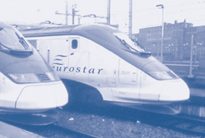 But that is not the end, because when Stage Two opens in 2007, it will be one year behind some major new links which will have opened on the continental side of the Channel, in the form of new lines from Brussels to Rotterdam and Amsterdam in the Netherlands, and to Cologne and Düsseldorf in Germany. Effectively, all the major capitals and commercial cities of this most densely populated central region of Europe— London, Brussels, Paris, Amsterdam, Cologne, Frankfurt—will be directly linked by high-speed trains traveling at up to three miles a minute.
But that is not the end, because when Stage Two opens in 2007, it will be one year behind some major new links which will have opened on the continental side of the Channel, in the form of new lines from Brussels to Rotterdam and Amsterdam in the Netherlands, and to Cologne and Düsseldorf in Germany. Effectively, all the major capitals and commercial cities of this most densely populated central region of Europe— London, Brussels, Paris, Amsterdam, Cologne, Frankfurt—will be directly linked by high-speed trains traveling at up to three miles a minute.
This will happen not a moment too soon, because the airports of this region have been suffering from rising traffic and increasing congestion—at least up to September 11, and doubtless again. London awaits a government decision on Terminal 5 at Heathrow, a dedicated British Airways terminal which would almost double the airport’s capacity; Paris expects a fi decision among eight alternative sites for a third airport; Amsterdam still debates how to provide additional capacity at Schiphol. The new rail network will relieve these airports, because at critical points—Paris Charles de Gaulle, Amsterdam Schiphol, Frankfurt International—it will directly serve them, allowing passengers to make a seamless connection from long-haulflight to high-speed rail feeder. Lufthansa already operates its own dedicated trains from Stuttgart to the Frankfurt airport, carrying passengers who have already checked in. Air France similarly allows train check-in to the TGVs from Lille to Charles de Gaulle. Despite the huge security complications arising from September 11, which can be resolved—Eurostar already employs European-level airline-style security—such rail-air integration must be the way of the future, and is likely to develop hugely after completion of the rail network in this, Europe’s Central Capitals region, in 2006–7.
So, not only the UK but Europe is constructing a largely new transportation system. That’s remarkable because it is an international enterprise: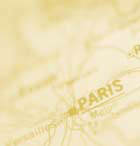 state-owned railways and private companies are cooperating to build and operate it, overcoming major technical problems such as different signaling and electrical systems.
state-owned railways and private companies are cooperating to build and operate it, overcoming major technical problems such as different signaling and electrical systems.
Is what Europe does today a likely prelude to what America will be doing tomorrow? The current confusion in the American airline system—fear of flying, massive loss of passengers, threatened corporate collapses—is symptomatic of basic security problems that high-speed rail travel might help resolve. On the East Coast many air passengers are switching to Amtrak’s moderately high-speed Boston-New York-Washington service, reflecting a pattern that has become common in Europe. Might that experience encour- age Congress to release federal funds for high-speed rail connections that, like those in Europe, would link many of America’s major cities? Might America’s airlines revive their fortunes as restructured air-rail corporations, buying into Amtrak as some European airlines have invested in rail?
Further Readings
Peter Hall, “East Thames Corridor: The Second Golden Age of the Garden Suburb,” Urban Design Quarterly, vol. 43, pp. 2–9, 1992.
Peter Hall. High-Speed Trains for California. Strategic Choice: Comparison of Technologies and Choice of Route (Volume I of II) (With Daniel Leavitt and Erin Vaca). Berkeley: University of California, Institute of Urban and Regional Development, Working Paper 564. 1992.
Martin Simmons, “The Impact of the Channel Tunnel,” The Planner, vol. 73 no. 3, pp. 16–18, 1987.

